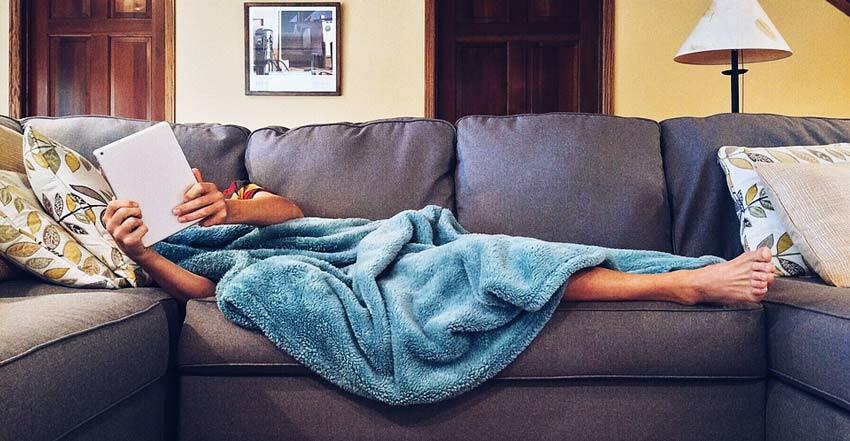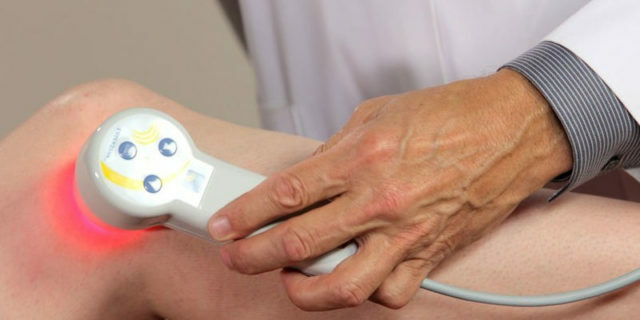
Contents of the page
- 1 The causes of synovitis of the knee joint
- 2 The role of fluid in the joints of the joint
- 3 Difference between the infectious and acute synovitis form
- 4 Treatment of synovitis of the knee joint
- 5 Popular methods of treatment of synovitis of the knee joint
- 6 Prevention of synovitis of the knee joint
In the human body, the knee joint is the largest. The responsibility incumbent upon him is also great, since the knee joint is subjected to enormous pressure when moving.
Therefore, if you take the statistics of ailments, it is the diseases of the knee that are frequent cases in traumatology. However, the knee is not only injured. Damage can concern not only the bone structure or ligament apparatus, but can cause dysfunction - synovitis of the knee joint.
This disease is characterized by the formation of serous exudate without particles of blood, in a moderate amount.
ICD 10 synovitis of the knee joint has been considering since 2007, under the code M65.
Causes of synovitis of the knee joint
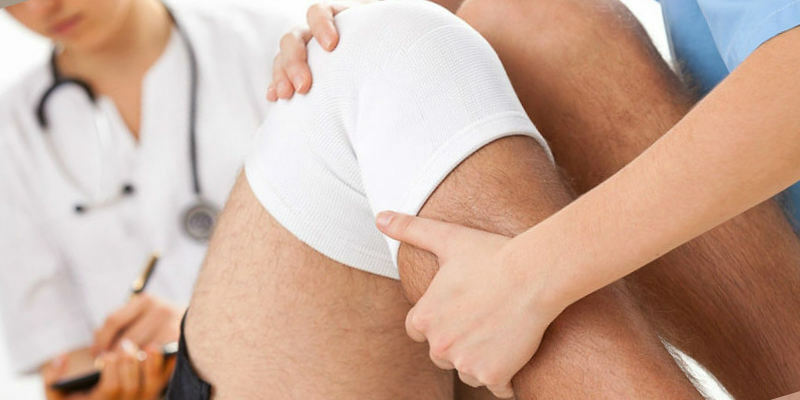
- Knee injuries( meniscus, ligament, fracture injury).You can get injured anywhere, at home, while playing sports, for example, hitting your knee, unsuccessful landing when jumping.
- Rheumatic Disease
- Presence of Allergy
- Syphilis
- Tuberculosis
- Gout, Diabetes Mellitus
- Age-related changes in joints
Depending on the origins of the disease, it can have different types:
- Primary, which is manifested due to underlying disease.
- Secondary, appears on the basis of a primary ailment or injury.
- Post-traumatic, accompanied by damage to the knee joint, as well as surgical manipulation.
- Infectious, which becomes the result of the manifestation of the vital activity of microorganisms. Thus it can be as nonspecific, that is caused by streptococci, pneumococci and staphylococcus, the herpes virus, advanced ARVI, sore throat or flu. It can be specific, that is, develop from a tuberculous bacterium.
- Aseptic, not having microbial sources. It may be caused by post-traumatic or allergic synovitis, based on other joint and body diseases. Its nature is based on the destruction of tissues, which entailed mechanical injuries, both of the knee itself and of the joint. Also, the development of aseptic synovitis gives rise to hemophilia, a disruption in the functioning of the endocrine system, and a metabolic disorder.
In the ICD 10 the synovitis of the knee joint is divided:
- - into serous synovitis
- - to serous-fibrous synovitis
- - to hemorrhagic synovitis
- - to purulent synovitis
Role of fluid in the joints of the joint
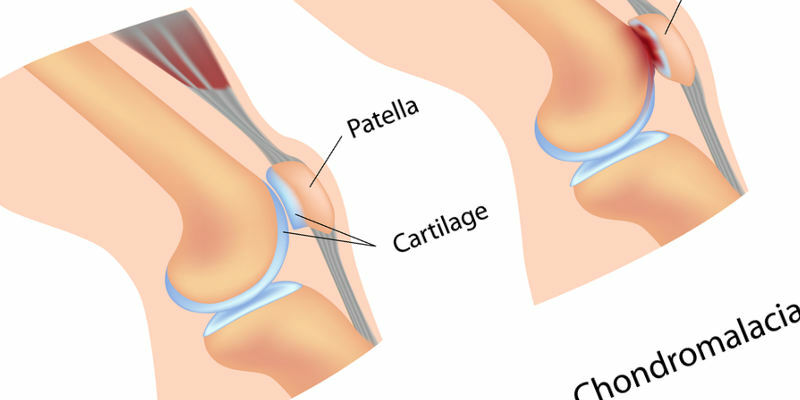
The knee has a difficult interconnection of bones. The basis of the knee is the tibia and femur, the patella. Inside the joint are two semirings of cartilaginous tissue - a meniscus. Together with all this joint, the knee is filled with ligaments, providing strength and functionality of the joint.
The knee has a "clutch" - an articular bag, which on the outside has a coarse fiber, and inside - a set of vessels that impose all connections on the surface. Because of its extensive structure, the shell in the face of the cartilage, bones, muscles and ligaments creates a variety of depressions, and wraps the knee
. The origins of the disease lie in the formation of fluid in the knee joint. The fibrous capsule secrets the accumulated fluid in the joint, which is covered by a synovial membrane consisting of a layer of cells. The liquid itself is proteins, minerals and carbohydrates, because it is a nutritious element of the cartilage in the joint, acting as a lubricant or shock absorber of the knee, saving it from all kinds of injuries. In a normal state, the volume of the liquid is 2 ml, which is maintained by resorption of intraarticular tissues.
The maintenance of balance in it is a delicate process, which can be easily broken if inflammation occurs. Thus, the appearance of synovitis of the knee joint increases the fluid, dramatically changing it from nutrients to bacteria, pus and blood, toxins and the like.
Difference of infectious and acute form of synovitis
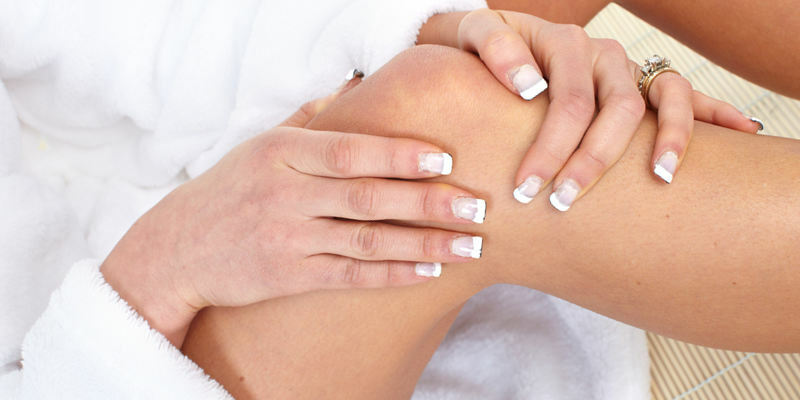
Aseptic synovitis, characterized by a large volume of the knee, which is not accompanied by any pain or other. When there is no pain, but there is the presence of volume - this is the consequence of the presence of irritation of the shell. The liquid in the joint bag can increase dramatically in quantity, up to one hour. Puffiness, which subsequently formed, would be a serious obstacle to freedom of movement.
This form of the disease can be accompanied by symptoms:
- total depletion
- no temperature
- is the joint volume that increases every instant
- by the joint dipping at the knee pressure
The moderate synovitis of the knee joint manifests itself in a small volume of the knee, while the patient can move freely without feelingpain. The general condition may worsen, but not significantly.
The acute form of synovitis is characterized by a sharp pain. If such an indicator exists. You should immediately consult a doctor to determine the source of the disease. Accompanying acute form:
- with joint increase
- with reddening of the knee, while the skin has an unpleasant shade, shiny, stretched
- high temperature throughout the body
- the patient feels exhaustion, muscle soreness
- acute pain at slightest stirring
Chronic synovitis of the knee joint is not accompanied by pronounced symptoms, but has a dull pain, together:
- with restriction of movement, fatigue
- crunch
- dislocation
Reactive synovitis can only occur in the ostoh shape which blends in chronic, in the absence of correct and timely treatment.
Diagnostic measures
 MRI of the knee
MRI of the knee The most difficult thing in diagnosing synovitis is the definition of the primary source, diagnose it, knowing the reason is simple.
The diagnosis of knee synovitis is accompanied by:
- Careful collection of anamnesis data, on the basis of which it is possible to confirm or refute a number of diseases.
- Professional examination of a specialist - palpation, general examination, under the accompaniment of tests.
- Carrying out studies, UAC and urine, examining the synovial fluid.
- Conduction of CT, MRI, ultrasound of the knee joint, radiography.
- Puncture and biopsy - in severe cases.
The diagnosis is a synovitis of the knee joint, with competent treatment, in principle, we will win. However, you need to know that full recovery can only be with serous and allergic synovitis. After the transfer of other varieties of synovitis, as a rule, stiffness of joints remains, with purulent formations, unfortunately, sepsis develops.
The complexity and danger of synovitis is precisely in the lethality of the outcome of the disease, and not in the preservation of mobility and the aesthetics of the knee joints. Therefore, one should not ask the question - how to treat the synovitis of the knee joint alone, relying only on grandmother's recipes and homeopathy. This is a serious undertaking and requires an appropriate approach.
Treatment of synovitis of the knee

The diagnosis of "synovitis of the knee joint" is treated in an outpatient setting. If the disease occurs in an acute form, it is necessary to tightly knead the knee in an even state due to a tight bandage. A bandage worn for more than 7 days is not recommended, as this will lead to joint tightness, which means - lack of mobility. Until the help is given, the knee should be wrapped in "cold" for 10 minutes.
Synovitis is treated in the following directions:
- removal of the source
- elimination
- malfunctions symptomatic therapy
- restorative therapy
- physiotherapeutic treatment
- LFK
therapy procedures are carried out as:
- carbon baths
- Baths with hydrogen sulfide
- radon and oxygen baths
- Currents at low frequency
- Ultrasound
- paraffin
- fangotherapy
- Infrared, ultraviolet and infrared radiation
 Photo: tablets from pressure
Photo: tablets from pressure MedicaMentosis treatment of synovitis of the knee joint is carried out by using:
- nonsteroidal anti-inflammatory drugs
- glucosteroid means
- chondroprotective agents
- inhibitors of proteolytic enzymes
If in the human body, there are pathogenic microbes and bacteria, tetracyclines, cephalosporins and macrolides, sulfonamides, depending on the source, are appointed. Circulation of blood is improved by intramuscular injection of heparin. To treat the wound - antiseptics, as well as rubbing and applying ointments - fastum, voltaren, indovazin.
It is important to understand that synovitis may be poorly administered to drug treatment, and also to have complications. In this case, surgery can be prescribed, in which partial or complete synovectomy is performed.
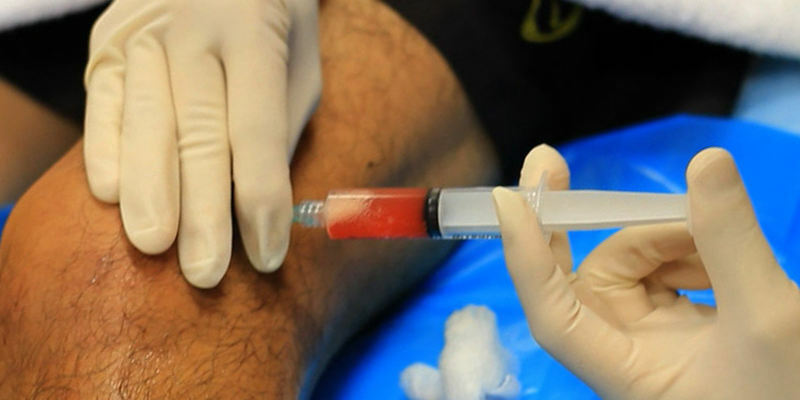
Carrying out a puncture is a necessary measure that is carried out without anesthesia, by piercing with a needle, a joint, and then the accumulated liquid is aspirated. Exudate can be sent to a laboratory study to obtain more accurate information.
After a surgical procedure, always carry out rehabilitative therapy by using anesthetics, antibiotics, physiotherapy, prescribe exercise therapy, gradually injecting the load onto the joint.
As an auxiliary therapy, and only after conducting a professional examination and correctly prescribed treatment, you can apply recipes from traditional medicine.
Traditional methods of treatment of synovitis of the knee joint
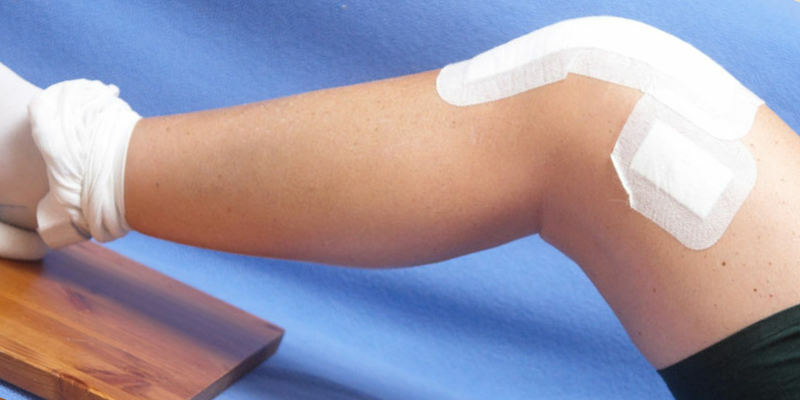
Treatment of synovitis of the knee by folk remedies involves the use of compresses from eggs, comfrey ointment, bay oil, various infusions. In particular, laurel oil has proved its worth. For its preparation, grind 2 tbsp.spoon bay leaf, cover the mixture of 200 gr.oil. The resulting composition is applied to the skin twice a day, fixing it with an elastic bandage.
For egg compresses, one egg and salt must be beaten. Blend the mixture on a knee, wrap it with an unsterile bandage, soak for 30 minutes.
You can prepare a comfrey ointment, from 200 g. Pork fat and a glass of fresh grass comfrey. Mix the mixture and insist 5 days in a cold place. Ready ointment applied to the knee several times a day, fixing an elastic bandage. This can perfectly help to restore cartilaginous tissue after surgery.

To prepare the infusion, you need to grind a lemon, 0.1 kg.garlic, 0.2 kg.celery root, mix everything in a container and pour three liters of water, leaving for 3 hours. Infusion is drunk three times a day for 60 ml.for 30 days. Among the recipes of traditional medicine can be found - salty ice. To make it you need to dissolve 4 tablespoons in 1 liter of water.salt, pour the mixture into an ice sheet and freeze. Ice cubes should be applied to a sore spot, after the formation of melt water, wrap the knee with a woolen cloth for 4 hours. Apply daily until it becomes easier.
Treatment of synovitis of the knee joint at home can be performed with the help of a unique honey. For the preparation of home medicine you need:
 propolis and honey
propolis and honey - - 1 kg of honey
- -500 ml.of vodka
- -200 gr.rye
- -2 liters.water
- - 7 gr.of the root of barberry
Among the methods, the treatment of synovitis of the knee joint at home, allows the use of special fees and teas for joints. Their preparation is not particularly difficult, and the composition does not hurt the body, helping to clear it of other diseases.
Put a container of water and stirred rye on the fire, which should be boiled for about a quarter of an hour. Then the brew cool and drain, pour honey into the mass, mix with barberry and vodka. Remove the mixture for three weeks in a dark place. The received medicine should be taken by 3st.spoons 30 minutes before meals. You need to go through the course three times a year.
Prevention of synovitis of the knee joint
You can not insure yourself against everything in life, but you can prevent the appearance of a disease, observing a healthy lifestyle. Although life is not allowed to do this. Therefore, after the transfer of the disease, you need to reconsider the habits, the culture of physical health, and shoes.
Shoes with high heels should be hidden away, before a special celebration and go to a more acceptable, heel height, choose an orthopedic model, use orthopedic insoles. It should also be reduced, but it is better to reduce too active sports that increase the burden on the knee, and also increase the risk of injury. For those who did not do sports before, on the contrary, it is necessary to engage in exercise therapy. It is necessary to monitor the diet, that it would be rich in nutritional elements and vitamins.

Follow-up, after treatment - recovery. Strengthening and recovery is carried out under the supervision of a physician. Among the exercises use:
- bike
- sit-ups
- walking up to 6 km per hour
- jogging
Medical gymnastics can be performed at home, starting from 5 minutes not earlier than seven days after the illness. The initial set of procedures consists in raising the straightened legs only 15 cm from the floor level. Hold it in this position it takes 2 minutes. Then you must carefully bend and unbend the foot, in the same initial position.
You can alternately lower and raise the leg, to start 5 times, and then gradually increase the amount to 15 to 10th occupation.
Consequences of
Untimely and incompetent treatment necessarily postpones its imprint on the joint, and also promotes the development of a number of concomitant. For example, periarthritis and phlegmon can develop. This is impregnation of tissues with pus, as well as muscles, tendons, fiber and skin around the joint. It may develop purulent arthritis and panarthritis. With the first disease, the pus spreads the outer shell of the joint capsule.
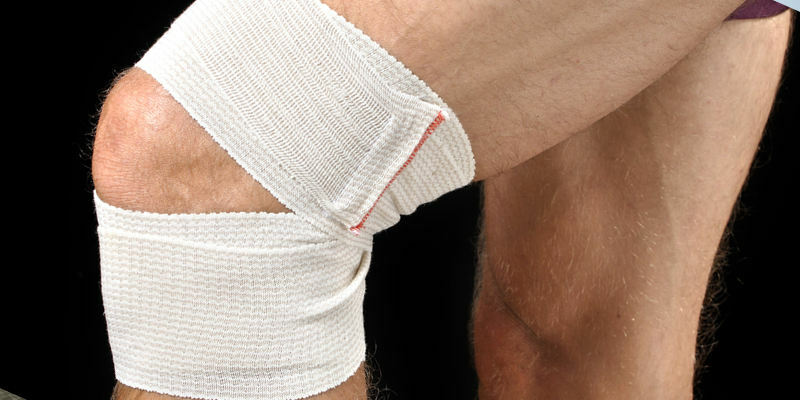
The second ailment captures the process of bone aging, joint and cartilage connections.
To be ill with a synovitis is not very pleasant, as it is not only painful, but also burdensome. On the forums and the Internet, you can meet many reviews about the disease and treatment.
Reviews
Review No.1
"I did not leave the synovitis for more than a year. Movement was reduced to a minimum, knees did not bend, / unbent. There was a panic, on the verge of despair, however, a competent approach to treatment, as well as a timely diagnosis of the inflammatory process in the body, helped stop the development of synovitis, allowing her to pass into the chronicle. The most important thing is to solve the problem on time and in a complex manner. The development of joints also helped not to become stiff, but against puffiness - massage with silicone jars »
Irina
Review №2
" I have been fighting with synovitis in the knee joint for two years. The victory is not always on my side, as it comes back again and again - the liquid is typed in the knee. He appeared during pregnancy, I washed the floors on my haunches. But the treatment, in view of my condition, was not prescribed. After I became a mother, I was removed a meniscus. However, there were no improvements. Despite the fact that all specialists say that my health is normal, the synovitis does not go away. Treatment courses were, many were prescribed, including antibiotics, chondroprotectors, puncture, currents, and baths were done. In vain, neither massages nor electrophoresis help. I'm desperate »
Maria
Reviewed by №3
"There was a sharp pain in the knee, after a doctor's examination, the diagnosis is a chronic synovitis of the right knee joint. I did not expect that something will help me, all the same. And many methods have been tried, starting with a puncture, paraffin, current, different baths of injections and ointments, electrophoresis, laser, leeches and so on. I was helped personally by mud applications and kinesiotherapy »
Igor

